Britain’s daily Covid cases have continued to climb today, official data revealed.
Department of Health bosses posted 33,074 new infections, up 9.5 per cent on last week’s figure of 30,215.
It is the seventh day in a row positive tests have increased week-on-week, marking a reversal in the sharp fall in cases that prompted hopes the worst of the third wave was over.
Covid deaths also increased by 9.3 per cent to 94 today, up from the 86 victims recorded last Thursday. But the overall trend appears to be levelling off.
Fatalities always lag behind cases by several weeks because of how long it can take between becoming infected and getting seriously ill.
Covid hospitalisation figures are also delayed for the same reason, however they have already dipped and now appear to be creeping upwards in line with the recent increase in cases.
Daily hospitalisations increased to 737 on Sunday, the most recent day figures are available for. This was up 1.1 per cent on the 729 the week before.
Meanwhile, a surveillance study today also claimed the number of people becoming ill with Covid every day has started to tick upwards once again, mirroring the trend seen in the Government’s own figures.
Data from the ZOE Covid symptom-tracking app shows daily cases fell two per cent in the week ending August 7, with infections hovering at around the 46,000 mark, before they started to pick up.
Professor Tim Spector, an epidemiologist at Kings College London and lead scientist on the study, said it is too early to tell whether the levelling off of cases will turn into another spike.
He warned of a slight increase in cases in over-60s, saying it could be caused by ‘waning immunity’ among those vaccinated earlier in the year. But Professor Spector also admitted it reflected the return of normal life, saying the trend may be caused by ‘lots of young and old people mixing again at large gatherings like weddings’.
Separate data from NHS Test and Trace revealed the number of people testing positive for Covid fell five per cent to 179,748 over the week ending August 4. And Public Health England’s (PHE) weekly surveillance report revealed cases were ‘stable’ last week. But PHE and NHS Test and Trace’s data lag slightly behind daily Covid numbers.
Scientists remain confused by the true state of the UK’s third wave and are at odds as to what will happen over the next few weeks.
Professor Steven Riley, an infectious disease expert at Imperial College London and member of a SAGE subgroup, warned cases could start to pick up again in September when children return to school.
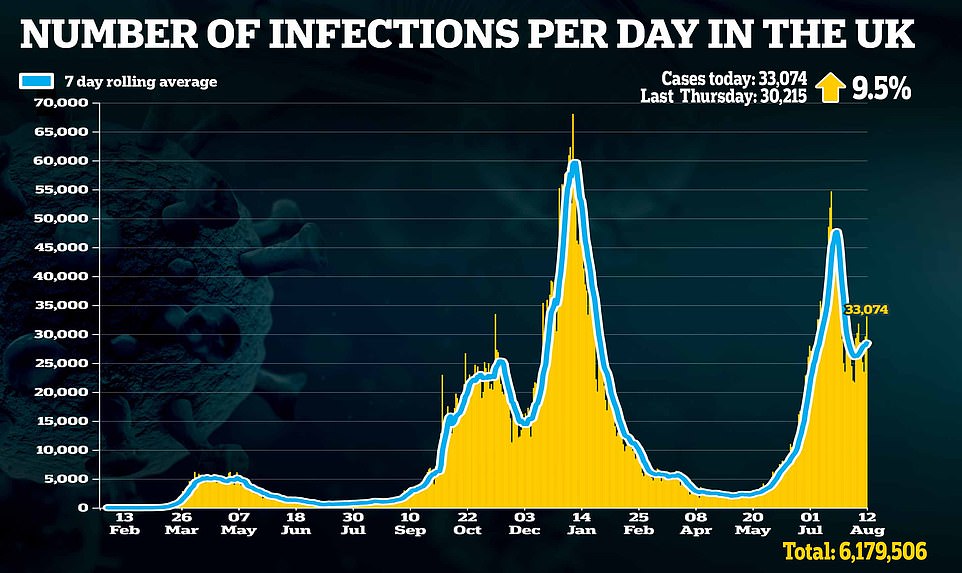

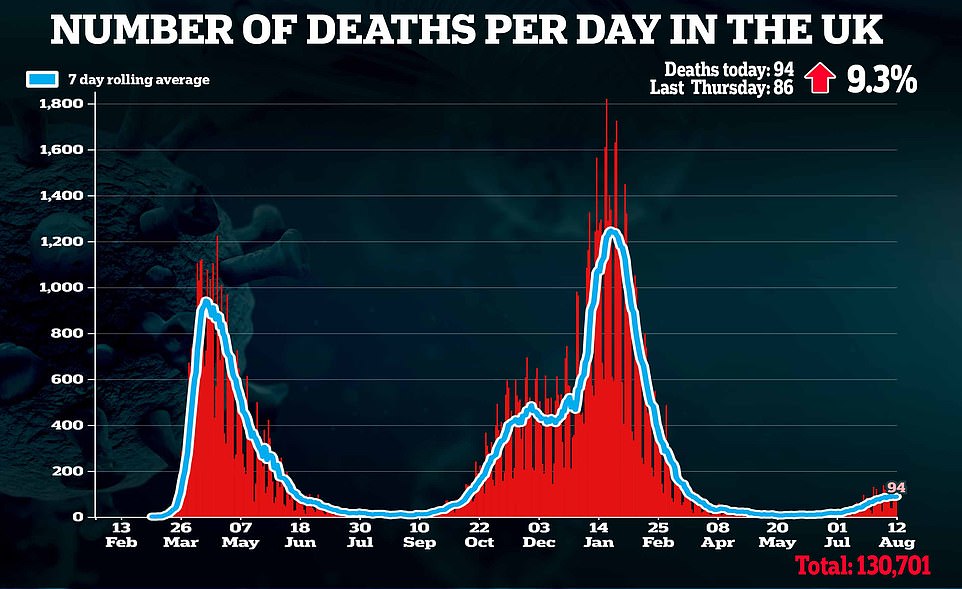

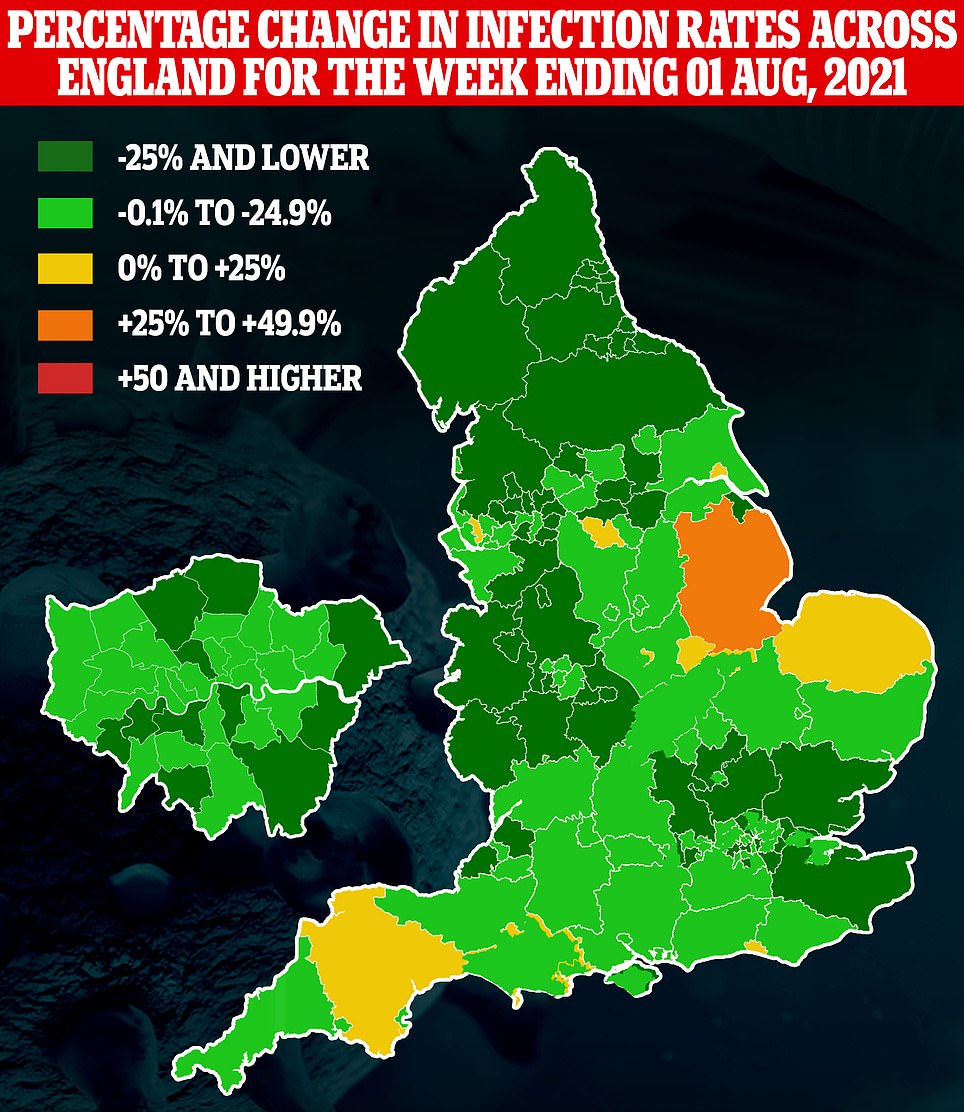
 ‹ Slide me ›
‹ Slide me ›
And Public Health England’s (PHE) weekly surveillance report revealed cases were ‘stable’ in the week ending August 8

Data from the ZOE symptom study shows daily cases rose slightly in people who have had both vaccine doses in the week ending August 7, from 10,751 to 11,043 — 2.72 per cent. They also rose in people who have had one dose — 6,534 to 7,168 (up 9.7 per cent) — and only fell in unvaccinated people — 29,620 to 27,700 (down 6.5 per cent) — but this could be caused by the fact more people were given jabs across the weeks.
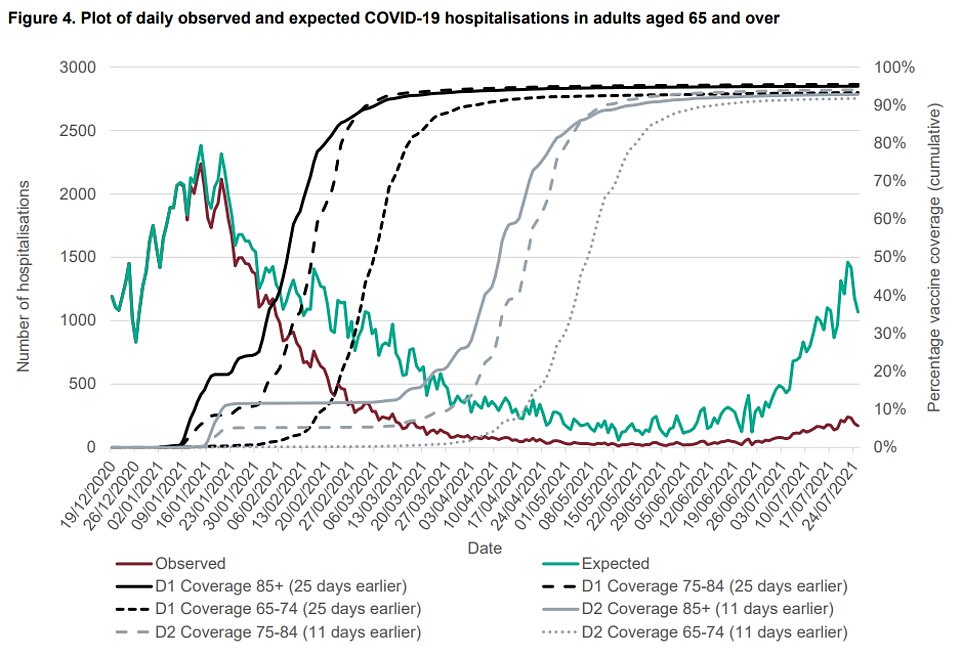
Graph shows: The number of hospitalisations in over-65s (brown line) plotted against the number of expected admissions without the vaccine programme (green line). The dotted lines show vaccine coverage in people aged 85 and above, 75 to 84 and 65 to 74 for first (D1) and second (D2) doses
Pingdemic pain eases again: Alerts sent by NHS app and Test and Trace call handlers fall by 20% in a week
The number of people forced to self-isolate after being pinged by the app or contacted directly by NHS Test and Trace has fallen by 20 per cent, official figures show.
NHS data shows around 610,000 adults were told to stay at home by the app or Test and Trace in the week ending August 4, down from 759,000 the week before.
In total, 789,791 people were told to isolate during the week when people testing positive are included. The same person can be contacted via the app and call handlers or test positive themselves afterwards, so the number in isolation is likely to be lower.
Pings still made up around 40 per cent of all self-isolation alerts, with calls from Test and Trace making up 37 per cent and positive tests being 23 per cent.
It comes ahead of a change to the rules allowing people who have had two vaccine doses or under the age of 18 to avoid self-isolation if they come into contact with Covid from Monday.
Advertisement
It comes as:
A World Health Organization chief admitted the world’s first Covid patient may have been infected by a bat while working for a Wuhan lab in China;New research suggested the current crop of Covid vaccines may not be as effective against the Indian ‘Delta’ variant compared to the original strain of the virus;A study revealed blood clots from AstraZeneca’s Covid vaccine are extremely rare but can kill up to a quarter of the few affected patients;MPs urged the Government to cap rip-off Covid PCR tests for travel that can cost up to £400 each at £40; A Government expert claimed people should receive a different Covid vaccine for their third jab because it will boost their immunity.
Week-on-week growth in cases accelerated today after infections appeared to be flattening out yesterday when they only rose by one per cent.
The growth in the seven-day average in cases — a more accurate barometer of how the pandemic is growing — also increased from 6.53 per cent yesterday to 8.61 per cent today.
Hospitalisations still appear to be falling on average, with the seven-day mean on Sunday decreasing by 5.4 per cent on the one recorded the week before.
But the rate at which they are falling is slowing, with the average change dropping from negative 8.8 per cent the week before.
The ZOE data, based on reports from more than one million Britons, shows daily symptomatic cases rose slightly in people who have had both vaccine doses, from 10,751 to 11,043 — 2.72 per cent.
They also rose in people who have had one dose — 6,534 to 7,168 (up 9.7 per cent).
Daily infections only fell among unvaccinated people — 29,620 to 27,700 (down 6.5 per cent).
But this doesn’t mean the current crop of jabs aren’t working, instead it reflects how most of the population have now had both doses.
Covid was most prevalent in Yorkshire and the Humber, where one in 72 were showing symptoms.
It was followed by London (one in 75), Northern Ireland (one in 76) and the North East (one in 81). For comparison, only one in 224 people in Scotland had signs of the infection.

The number of people falling ill with Covid every day fell slightly to 45,911 last week, the ZOE symptom-tracking study has revealed but experts warn they are ‘seeing sign of an uptick’

The number of people told to self-isolate by the NHS app or directly from Test and Trace has fallen by 20 per cent in a week

Pings made up around 40 per cent of all self-isolation alerts in the week ending August 4, with calls from Test and Trace making up 37 per cent and positive tests being 23 per cent
Vaccines have already prevented 84,000 Covid deaths and 23.4million infections, PHE says
The Covid vaccine rollout in England is estimated to have prevented more than 84,000 deaths, according to new figures from Public Health England.
PHE said on Thursday that 84,600 deaths and nearly 23.4million infections have been prevented as a result of the vaccination programme up to August 6.
Estimates of how many hospital admissions in England have been directly averted by the vaccine remain unchanged at 66,900.
The latest estimates for deaths and infections prevented as a result of the Covid-19 jabs rollout ‘show the vaccine programme’s remarkable impact on saving lives and reducing the spread of the virus’, said Dr Mary Ramsay, head of immunisations at Public Health England.
She said: ‘As cases have increased, the true scale of protection from the vaccine programme has become clear. Everyone that has come forward for their vaccine has played a part in this vital effort.
‘It’s important that people under 30 years of age continue to take up the offer of the vaccine. Infection rates are highest in this age group, and Covid-19 can be serious for some.’
Advertisement
Professor Spector said: ‘The decrease in cases that we saw last week appears to have faltered over the last few days, and we’re seeing signs of an uptick. However, it’s too early to say if this is a start of another steep increase like the one we saw in July.
‘While it’s reassuring to see loosened restrictions haven’t caused cases to sky rocket, it’s more difficult to predict the future.
‘Cases remain relatively low in the fully vaccinated group, which is a sign that vaccines are working and keeping the spread at bay.’
He continued: ‘The current picture reflects some level of normal life returning to the UK.
‘As a result we have lots of young and old people mixing again at large gatherings like weddings, which still carries risk with high case numbers and varying vaccination statuses between generations.
‘We’ve recently observed a slight increase in cases in the over 60s who were vaccinated some time ago. This could be due to waning immunity and we’re keeping a close eye on the performance of vaccines over time.
‘The key to reducing spread is to stay at home if you have symptoms, however mild and whatever your age.’
He added: ‘It’s also important to highlight that the data has an ever decreasing number of unvaccinated and partially vaccinated contributors as more people get their 2nd jab, so we are treating the data in these groups with caution.
‘As always we are working hard to keep up with the pace of this pandemic so the ZOE team is looking at our methods to make sure we’re as accurate as possible.’
Meanwhile, NHS Test and Trace figures revealed the number of people testing positive fell five percent in the week ending August 4 to 179,748.
It was down on the 189,710 recorded the week before and just over half the amount recorded during the apparent peak of the third wave in the week ending July 21 (308,647).
Case rates have risen in all regions of England except the north-east, according to Public Health England’s report.
Yorkshire and the Humber has the highest rate, with 372.4 cases per 100,000 people in the seven days to August 8, up week-on-week from 359.7.
The East Midlands has the second highest rate: 338.5, up from 312.7. South-east England has the lowest rate: 255.0, up from 234.0. In the north-east the rate fell from 325.5 to 286.4.

Separate data from NHS Test and Trace revealed the number of people testing positive for the virus fell five per cent to 179,748 over the week ending August 4
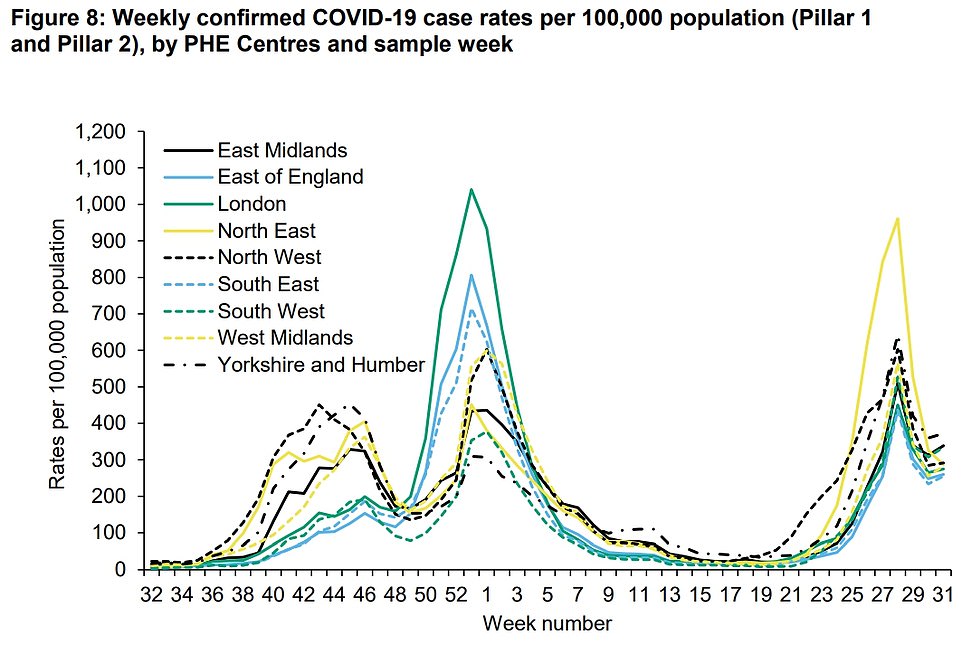
Case rates have risen in all regions of England except the north-east. Yorkshire and the Humber has the highest rate, with 372.4 cases per 100,000 people in the seven days to August 8, up week-on-week from 359.7. The East Midlands has the second highest rate: 338.5, up from 312.7

Infection rates in England have risen among all age groups except 10 to 19-year-olds, according to Public Health England’s weekly surveillance report data

Covid was most prevalent in Yorkshire and the Humber, where one in 72 were showing symptoms. It was followed by London (one in 75), Northern Ireland (one in 76) and the North East (one in 81)

The number of people pinged by the NHS Covid-19 app in England fell 20 per cent to 310,887 in the week ending August 4, down from 388,265 the week before
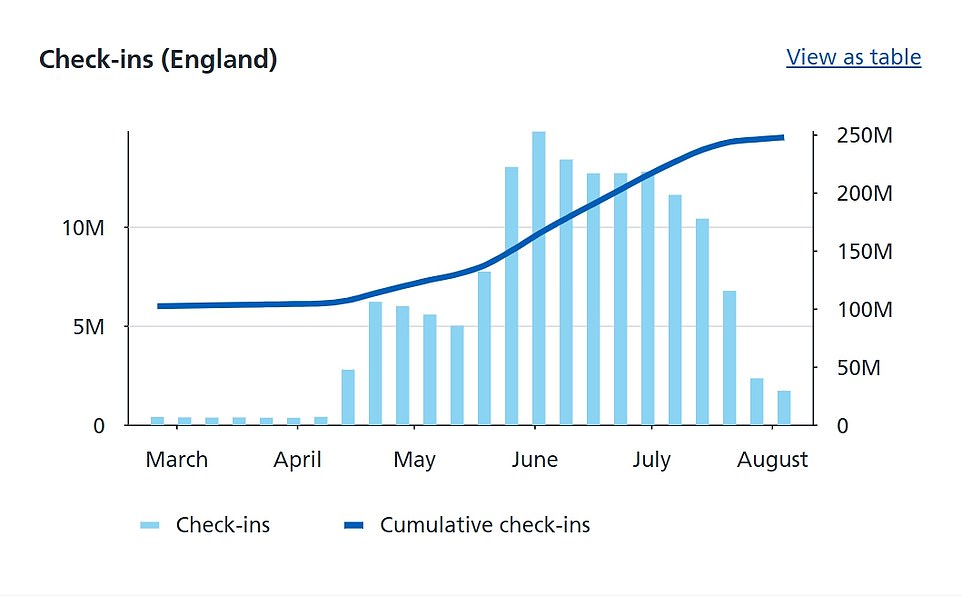
The drop-off in the number of venue check-ins using the app was similar during the week, falling 26 per cent from 2.3million to 1.7million
Rates in England have also risen among all age groups except 10 to 19-year-olds, Public Health England said.
The highest rate is among 20- to 29-year-olds, with 670.7 cases per 100,000 people in the seven days to August 8, up week-on-week from 628.6.
The second highest rate is among 10- to 19-year-olds, down from 515.4 to 456.1. The lowest rate is among people aged 80 and over: 66.6, up slightly from 65.0.
Dr Yvonne Doyle, medical director for Public Health England, said: ‘Data suggests that Covid-19 cases are currently stable, although rates remain high across the country.
‘Vaccines are breaking the link between infections and serious illness, and on Monday the rules will change so that those who have been double jabbed for at least two weeks, or are under 18, don’t need to isolate if they are a close contact.
‘Even if you have had both doses, if you are a close contact you should still get a PCR test as soon as you can and consider wearing a face covering in enclosed spaces, and limiting contact with other people, especially with anyone who is clinically extremely vulnerable.’
She encouraged all eligible young people to get a jab ‘so you can take your next steps in life safely’.
Public Health England’s figures also revealed the vaccine rollout in England is estimated to have prevented more than 84,000 deaths, according to new figures from Public Health England.
PHE said 84,600 deaths and nearly 23.4million infections have been prevented as a result of the vaccination programme up to August 6.
Estimates of how many hospital admissions in England have been directly averted by the vaccine remain unchanged at 66,900.
The latest estimates for deaths and infections prevented as a result of the Covid jabs rollout ‘show the vaccine programme’s remarkable impact on saving lives and reducing the spread of the virus’, according to Dr Mary Ramsay, head of immunisations at Public Health England.
She said: ‘As cases have increased, the true scale of protection from the vaccine programme has become clear. Everyone that has come forward for their vaccine has played a part in this vital effort.
‘It’s important that people under 30 years of age continue to take up the offer of the vaccine. Infection rates are highest in this age group, and Covid can be serious for some.’
Despite the effect of vaccines in dampening deaths and hospitalisations, Imperial’s Professor Riley said he expects cases to start rising again when people start socialising indoors more in autumn.
Asked about how the pandemic could change in the coming months, he said: ‘I think it is possible that it stays stable or even declines through September and October but I don’t think that’s the most likely outcome.
‘Children not being in school, many people not going to the office to work, and it being very easy to socialise outside, those things are currently in our favour and will go against us as we move into September and October.
‘Even with the additional vaccination there is going to be a bit of upward pressure so I think there’s a reasonable chance that the prevalence will start to tick up again at some point during September.
Professor Riley added the recent fall in cases may have been caused by schools closing over summer and the end of the Euro 2020 championship, which had raised infections during the start of summer.
He said: ‘We’ve got lots of immunity in the population now, the vast majority of that is driven by vaccination.
‘But also that most recent peak that we saw was probably related to the Euros a little bit and the end of the school year.
‘Some data from the REACT study saw a very high rate of infections in men compared to women which is unusual, suggesting perhaps that social patterns of men had changed, and then also we saw very high levels of infection in school-aged children.’
Source link : https://www.dailymail.co.uk/news/article-9887963/Britains-daily-Covid-cases-jump-10-week-33-074.html











